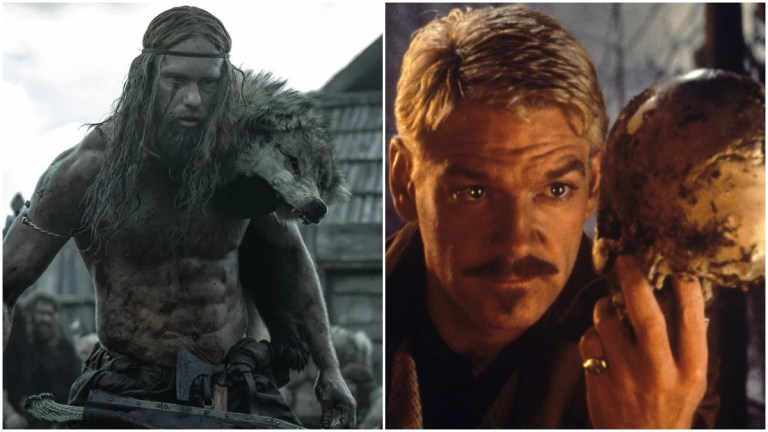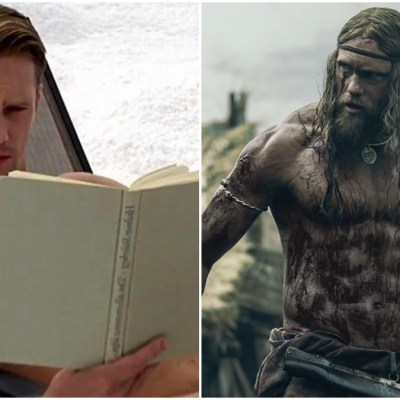The Northman, Hamlet, and the Story Both Are Based On
Robert Eggers’ The Northman adapts and reimagines the Viking tale that inspired Shakespeare’s Hamlet.

This article contains The Northman spoilers.
“To be or not to be.” That is a question which never occurs to Alexander Skarsgård’s Amleth in The Northman. He knows exactly what he’ll be next week. It’s the same thing as last week: a bloodthirsty Viking. Nevertheless, the character has much in common with William Shakespeare’s Danish prince, who famously uttered the above quote during a soliloquy in Act Three of Hamlet. And whether viewers are familiar with the Bard’s tragedy or not, that connection to Elsinore pervades throughout this weekend’s bare-chested epic.
“I felt if I’m doing Hamlet or The Lion King, I have a story that the audience knows already,” The Northman director Robert Eggers told Den of Geek Magazine. “So therefore I can really indulge in the world-building without confusing people.”
Indeed, there is something primordial about the storytelling in Eggers’ film. Working from a screenplay he co-wrote with the Icelandic poet Sjón, Eggers retrods a deeply classic saga in which a son (Alexander Skarsgård) avenges the murder of his kingly father (Ethan Hawke) by slaughtering the uncle who is to blame (Claes Bang). It’s the basic plot of, yes, Hamlet and The Lion King, but as presented by Eggers, it takes on a primal, bestial form in which hellish vistas like an erupting volcano play host to the sight of two naked men trying to hack each other to death. It’s foreboding and stimulating… and it feels like part of a shared past.
That’s because The Northman owes something to its audiences’ familiarity with the Hamlet tale, whether they’re conscious of it or not. After all, Hamlet, in turn, owes something, too, to the Viking culture which originated its plot…
Amleth Before Hamlet
“It’s a very old saga,” Skarsgård explains when we bring up the root origins of his film’s tale. “Shakespeare based his Hamlet on Saxo Grammaticus’ Prince Amleth from the 12th century. But Saxo Grammaticus most likely based Prince Amleth of Jutland, which we based our movie on, on an even older Icelandic saga from the ninth or 10th century.”
While there is no existing surviving 10th century saga of Icelandic origin to exactly confirm Skarsgård’s assertion, the actor is not wrong. Many scholars of medieval literature out of northern Europe seem to agree that the legend of Prince Amleth, which in turn inspired Shakespeare, does go back several hundred years prior to the birth of Saxo Grammaticus—or when most oral Icelandic sagas were finally written down in the 13th century.
Still, the most famous medieval version of the story is the one penned by Saxo Grammaticus in either the late 12th or early 13th century. Saxo Grammaticus was a Danish historian, theologian, and author, who—unlike the Icelandic poets and authors of sagas from which the dialogue in The Northman takes its inspiration—tended to write from a scholarly perspective, including by writing in Latin and by depicting clearly embellished stories like that of Amleth as historical events.
According to Saxo Grammaticus, Amleth was a prince of Jutland, which was a northern kingdom in medieval Denmark. There’s also a slightly older version, also of Danish origin, and which was likewise written in Latin, from a piece of scholarship called Chronicon Lethrense. That version is also set in Jutland.
Even so, the name of Amleth itself is likely derived from the Old Icelandic word “Amlóði,” which is a moniker that appears once in the Edda, an Old Norse textbook from the 13th century which is the primary surviving source for our understanding of Norse mythology. This gives credence to the theory that the story of Amleth goes back to a forgotten Icelandic saga from the Viking Age. And for what it’s worth Icelandic historian Thormodus Torfæus recorded that in his youth—which would’ve been in the early 1600s—the legend of “Amlodi” was a popular one shared among children.
“Saxo Grammaticus was very knowledgeable about the Icelandic sagas,” says Eggers, “and we would imagine that he read an earlier Icelandic version of Amleth that was most likely a tale that was passed down orally and existed during the Viking Age. There’s also a saga called Hrólfs Saga that the opening of is very similar to the story of Amleth and Hamlet. So it’s an old Norse story.”
Differences Between the Original Amleth and The Northman
What might surprise folks, however, is that Saxo Grammaticus’ Amleth has arguably more in common with Shakespeare’s Hamlet than it does The Northman. This shouldn’t be a total surprise since Shakespeare likely discovered a French translation of Saxo Grammaticus’ work from the 15th century, hence how he was inspired to write Hamlet.
And like that famed English play, the most well-known surviving version of Amleth has a lot more courtly intrigue and subterfuge than Robert Eggers’ film. In the Danish text, Amleth is the son of Jutland’s King Horvendill, who after a successful expedition that led to him slaying one of the kings of Norway has returned home to marry Gerutha, a princess from another Danish kingdom. He thus sires Amleth. Unfortunately for Horvendill, he also has a brother named Feng, who, out of jealousy for Horvendill’s power and wife, murders him. Feng then seduces Gerutha by convincing her that Horvendill hated her and was a brutish man.
Feng also plans to kill his nephew Amleth but is convinced not to by the wily young prince, who feigns stupidity and acts a fool. As with Hamlet, the scheming uncle sets a series of traps to test his nephew’s supposed madness, including by having Amleth’s foster sister attempt to seduce him (the origin of Ophelia). But after Amleth winds up murdering one of his uncle’s eavesdroppers during a confrontation with his mother, Feng decides to do away with Amleth by sending him to England where a letter will consign him to death. However, Amleth steals the letter and alters it in the night so that his guardsmen are the ones put to death, and further Feng’s English ally must marry his daughter to Amleth!
After securing a wife, Amleth returns in the night to his home where Feng has a funeral feast in Amleth’s supposed honor. In disguise, Amleth gets all the Viking men drunk and then in their stupors, traps them under a tapestry and lights it on fire. He goes on to slay and behead his uncle, eventually forgive his mother after she begs his pardon, and return to England and have further adventures in Scotland where he also seduces and marries a Scottish queen, returning to Denmark with two wives! (Eventually, like any good Viking, he dies in his older age in battle.)
So it’s not quite Hamlet or The Northman, but the roots of both are there. Perhaps sometimes more than even Eggers will currently admit.
How The Northman Deconstructs Hamlet
When we spoke to Eggers about the film, he noted the story of Amleth was a larger inspiration for him to chase his own Berserker ghosts. The filmmaker wanted to use that basic framework of familiarity to keep the audience keyed in to what is happening, even when weird things like Bjork as a supernatural Seer appears, compelling Amleth to stop his raiding ways and seek a righteous revenge instead.
Even so, there are more than a few elements of The Northman lifted directly from Shakespeare’s Hamlet (and not Amleth), only now with a modern subtext.
For instance, in Hamlet, the Danish prince discovers a gravedigger excavating a burial site, only to find the skull of his father’s court jester. The Danish prince becomes melancholic recalling poor Yorick and the merry memories of kissing his lips and laughing at his japes. Well, that court jester is a major character in The Northman, played here by Willem Dafoe. As Heimir the Fool, Dafoe portrays perhaps the one person Hawke’s King Aurvandil shows genuine affection toward. He is allowed to tease what he sees to be the wandering eye of Queen Gudrún (Nicole Kidman), and he is shown indoctrinating young Amleth into the Viking customs and superstitions of his father.
When Amleth infiltrates Iceland some decades later, feigning to be a Slavic slave, a He-Witch (Ingvar Sigurdsson) manifests to reveal the decapitated remains of Dafoe’s fool. Apparently after Claes Bang’s Uncle Fjölnir assumed the throne he stole, one of his first acts was to torture and behead Heimir. “Alas,” says the He-Witch to Amleth. Yet after the new king’s torturers removed the fool’s tongue and eyes, and later his head, a pagan witch retrieved the remains, restoring the skull to ghastly shape. And now it’s been brought to Iceland in order for Amleth to commune with the dead… much as Hamlet wished to do with poor, poor Yorick.
The Northman is filled with these little flourishes and nods to the Bard, even as it is draped in a decidedly more medieval and bloodlusty fashion. The most significant of these is the transformation of the Gertrude role. As the queen mother who marries her dead husband’s brother within a fortnight of the king’s death, the motherly role of Hamlet is one of Shakespeare’s most underwritten lead characters. What did she see in her husband’s brother, the murderous Claudius, and why does her son loathe her so? Is it only because of her hasty second wedding?
Eggers and Sjón’s The Northman screenplay embraces some of the Freudian interpretations of Hamlet that became popular in the last hundred years while also bringing a strikingly modern understanding to the woman’s perspective in this world. In the case of the former, Oedipal subtexts are heightened when in her first scene, Kidman’s Gudrún is introduced changing—and she immediately scolds her son for barging into her chambers without permission to enter.
In Kidman’s biggest scene, Amleth enters her chambers again without knocking, now as an adult and in a different house. This is the moment in Hamlet where, via accusations of lust and shame, the son is able to break through to his mother about her sins. But in The Northman, when Amleth confronts Gudrún about what she’s become, and demands she ready herself for liberation, she doubles down on her “sins” and forces her son to confront his own.
“I see you’ve inherited your father’s simpleness,” she mocks in what becomes a stunning revelation that not only was she happy to become Fjölnir’s wife, but she was the one who begged him to kill her husband, whom she never loved. In a confession that Amleth’s simplicity cannot comprehend, Gudrún was a victim of this culture before a queen in it—a slave whom his father elevated to his queen simply because she was the first of his concubines to bear him a son. Further, Gudrún reveals she urged the uncle to also murder Amleth, her son, cleaving all memory of a wretched man from her life.
This confession, as well as her almost mocking kiss, in which she accepts that if he kills Fjölnir Amleth would be her new lover, speaks to a long speculated upon psychological lust between Gertrude and Hamlet, and a likely disdain for the son’s father. In a patriarchy where women are traded for power, literally so in Gudrún’s case in The Northman because she (like Amleth’s lover, Olga of the Birth Forest) is a slave, what does it mean to be loyal or faithful? In a strange way, this returns to the original Amleth tale in which the father’s wife knows her brother-in-law killed him… and celebrates the fact because she knew the old king used her only for childbearing.
In the end, Kidman’s Gudrún is far more hungry for Amleth’s blood than that of her husband in The Northman, being the first to tell their guards to slay her son after Amleth reveals himself on a hillside later in the movie. Eggers takes one of the most ambiguous mysteries in the Shakespeare canon and makes it so much more twisted.
And, by the film’s end, after Amleth has killed his mother and half-brother, his uncle no longer even looks like the villain. It’s a classic yarn given bloody new bite.


